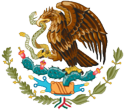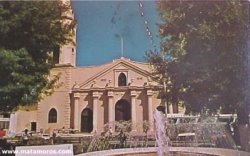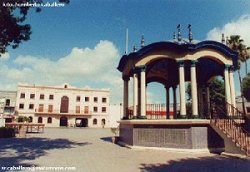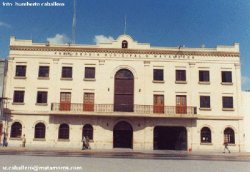 Matamoros, Tamaulipas, Mexico
Matamoros, Tamaulipas, Mexico
The Place of the Beautiful Marshes
Capitan Juan José de Hinojosa explores the region in 1706.
He was amazed by the number and beauty of the marshes that characterized the
area. As a result, the Capitan named the area "Paraje de los Esteros Hermosos"
(Place of the Beautiful Marshes).
In 1749 don Matías de los Santos Coy established a cattle
ranch called "San Juan de los Esteros Hermosos" (San Juan of the Beautiful
Marshes). This ranch was located in an area currently occupied by the northeast
corner of 5th and Matamoros streets. don Matias was forced to abandon his ranch
due to the frequent Indian attacks he suffered.
The Thirteen Families
The area was plagued by frequent floods caused by the Rio
Grande. In 1747 don José de e Escandón and Capitan Blas María de la Garza
categorized the area as poor for future development. This act did not stop 13
enterprising families from establishing themselves there. In 1774 the 13
families founded a congregation also named "San Juan de los Esteros Hermosos".
The site of the congregation was the same previously occupied by don Matías de
los Santos Coy.
José de e Escandón and Capitan Blas María de la Garza
categorized the area as poor for future development. This act did not stop 13
enterprising families from establishing themselves there. In 1774 the 13
families founded a congregation also named "San Juan de los Esteros Hermosos".
The site of the congregation was the same previously occupied by don Matías de
los Santos Coy.
Capitan Ignacio Anastacio de Ayala, who was given
authority over said congregation, procured the deeds to 113 mayor cattle sites
in favor of the founding families. These families were the city of Matamoros'
origins. To this day, their descendents are prominent families in the area.
La Villa del Refugio (Town of Shelter/Refuge)
In 1793 Franciscan friars from the Apostólico de Guadalupe
Zacatecas college arrived to the congregation and proposed a new name for the
community. Keeping in mind the patron saint of the missionaries, the area was
renamed "Nuestra Señora del Refugio de los Esteros" (Our Lady of the Refuge of
the Beautiful Marshes).
The inhabitants came to know the area as "El Refugio" (The
Refuge) o "Villa del Refugio" (Town of Refuge). As a result of the frequent
flooding, the original site of "Villa del Refugio" was changed. In 1814 it was
relocated to the main plaza which was considered the highest area in the
township.
Villa de Matamoros (Town of Matamoros)
 In 1826 governor Lucas Fernández issues a decree assigning
a new name to "Villa del Refugio". The governor baptized the city as "Villa de
Matamoros" in honor of the independence hero don Mariano Matamoros.
In 1826 governor Lucas Fernández issues a decree assigning
a new name to "Villa del Refugio". The governor baptized the city as "Villa de
Matamoros" in honor of the independence hero don Mariano Matamoros.
The name has remained until modern times. In 1834 the area
raised to city status.
In 1851 the city is heroically defended against aggressors
who had recently signed the "Plan de la Loba". General Francisco Avalos' troops
and civilians under local president Macedonio Capistrán's command fended off the
enemy.
Thank to this victory, state congress grants the city the
"Invicta" (undefeated) and "Heroica" (Heroic) titles. The federal government
also grants the city the title of "Leal" (Loyal) thanks to its inhabitants
protection. Hence, the "H" before the city's name refers to the title of
"Heroica"
The Cotton Era
The so called Cotton Era took place between 1948 and 1962.
During this time, Matamoros experienced an economic peak. The economy flourished
and the quality of the cotton made in the city was recognized globally. However,
with time cotton prices dropped as the popularity of synthetic fibers used in
clothing increased. Currently, the area is a leading farm producer of zorghum.
The "Maquiladora" Industry
Currently, Matamoros' main economic activity is the
maquiladora industry. This industry has steadily developed since the sixties.
Currently, the city boasts of approximately 150 plants. The Maquiladora industry
is a source of employment for many "Matamorenses" as well as many people from
outside of the city who establish there. The industry has become a growth and
development factor for the entire region.
industry has steadily developed since the sixties.
Currently, the city boasts of approximately 150 plants. The Maquiladora industry
is a source of employment for many "Matamorenses" as well as many people from
outside of the city who establish there. The industry has become a growth and
development factor for the entire region.
The city is 1,779 miles from
Washington D.C.
The U.S. Consulate
Matamoros is home to what some believe to be the oldest
U.S. Consulate in continuous service, having opened in the 1850s. The only
diplomatic mission in Matamoros, it has played an important and historic role in
the region's development. The Consulate was slated for closure in 1995 after a
round of Congressional budghet cuts identified several smaller U.S. diplomatic
missions as likely candidates for termination; however, high demand for business
and tourist visas to the United States in the wake of NAFTA led the
U.S. Department of State to remove Matamoros from the "closure list." In
1999, the Consulate was actually expanded. In 1998, Consulate Matamoros was the
first U.S. diplomatic post in the world to begin issuing "Laser Visas," new
"high-tech" visas with digitally-recorded biometric information about the
applicant. George Kopf, a career Foreign Service Officer, was the Consul-general
at the time of the "Laser Visa" program's implementation; David Schlaefer,
another career officer originally from nearby McAllen,
Texas, was the
Visa Chief that oversaw the implementation.